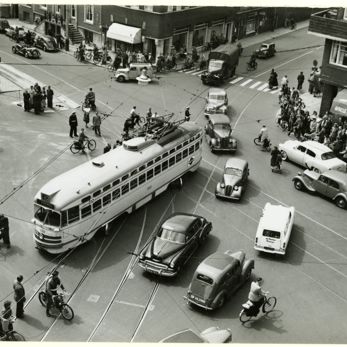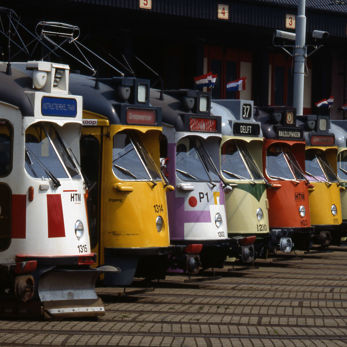Our history

The city of The Hague made history in 1864 with the first horse-drawn tram in the Netherlands. Over 150 years later HTM trams are still inseparably part of the city centre and it is impossible to imagine the cityscape without them.
Our tram network expanded considerably since the 1970s, which means that we are now connecting more and more passengers with work, home and with each other. Thanks to its great international attractiveness, The Hague is increasingly developing into a metropolis, and this growth is happening hand-in-hand with the growth of our network.
We want to actively respond to this growth by providing good public transport that runs frequently, provides more space and is accessible to all passengers. By using new technology, innovative thinking and good collaboration we can better satisfy the needs of our passengers and life in the metropolis, both now and in the future!

1864 - the first horse-drawn tram
In 1864, The Hague had the first in the Netherlands, the first horse-drawn tramway! On 21 March 1864, the Dutch Tramway Company was founded.

1880 - only 1 horse
Hollands Spoor and Rhijnspoor stations (later Staatsspoor and today Centraal Station) were given a tram connection to the city centre.

1887 - HTM is born!
NV Haagsche Tramweg-Maatschappij (HTM) acquires Belgian company Société Anonyme des Tramways de La Haye on 17 May 1887. HTM was born!

1904 - the electric longline tram
Due to numerous technical problems, the battery tram had to give way to the electric longline tram, which was inaugurated with appropriate celebrations.

1915 - a day at the beach
Scheveningen had long been the main destination in summer. After a day at Scheveningen, everyone wanted to go home at the same time and there were long queues at the stop in front of the Kurhaus.

1916 - conductresses on the tram
Although the Netherlands stayed out of World War I, many men were deployed to guard the borders. As a result, conductresses appeared on trams from 1916.

1926 - The Hague modernises
HTM operates 16 tram lines, many of which reach the city outskirts. The Hague had nearly 410,000 residents accounting for 53 million tram and bus trips a year.

1929 - ambitions in trouble
The economic crisis following the stock market crash of October 1929 marked the end of many ambitions. Growing unemployment led to less transport and hence less revenue.

1935 - one-man car
Due to the crisis and declining passenger numbers, one-man wagons were increasingly used. The trailers increasingly stayed in the depots.

1939 - 75 years of trams
Due to the crisis and declining passenger numbers, one-man wagons were increasingly used. The trailers increasingly stayed in the depots.

1940 - The Hague in the firing line
Although the aim was to allow normal life to continue as much as possible after the capitulation on 14 May 1940, many things changed immediately.

1943 - tram trusses
The number of tram passengers rose stormily, from 60 million in 1940 to 138 million in 1943. As a result, the tram was soon too full and this led to 'tram crosses'.

1949 - a new beginning
After the war, mass production made cars so cheap that more and more people could afford one. Responding to this development, a modern, comfortable tram was developed.

1960 - advertising on tram
Besides ticket sales and government contributions, transport companies get a third source of income: advertising. Today, the heavy enamel billboards are popular collector's items.

1965 - stamping machines
To make the service more efficient, some trams received stamping machines in autumn 1965. At the first door you could buy a ticket and the second door was for passengers with a stamp card.

1966 - 90 years of bus
Moderately occupied tram lines were replaced by bus lines. HTM bought 330 dark red examples of the DAF/Hainje brand.

1975 - double lines
In 1975, HTM came up with a new vision for the future of the tram network and opened the new Central Station. This new station could handle many more passengers than the old Staatsspoor station.

1981 - double articulated trams
HTM designed a double articulated tram on eight axles, the GTL-8. Over 100 of these more than 26-metre-long trams in red and beige colours went on to define the street scene.

1993 - last deployment PCC
The PCCs' deployment came to an end in 1993. At the Zichtenburg depot, all the painting variants that were available at the time were set up.

2004 - tram tunnel under city centre
Due to congestion at the intersection Spui/Kalvermarkt/Grote Marktstraat, Grote Marktstraat was tunnelled under. Construction started in 2000 and was completed in 2004.

2006 - introduction RandstadRail
A few years later than anticipated, RandstadRail was realised in 2006. RandstadRail connects The Hague with the surrounding Zoetermeer and Rotterdam region.

2015 - introduction of new city tram (Avenio)
The Avenio was introduced into the timetable at the end of 2015. HTM operates 70 Avenio trams on various lines.

2019 - introduction of electric bus
Electric buses were introduced in the timetable in 2019. HTM operates eight electric buses on line 28.
"Where would all these Hagenaars and Hagenezen be without a Haagse tram".

